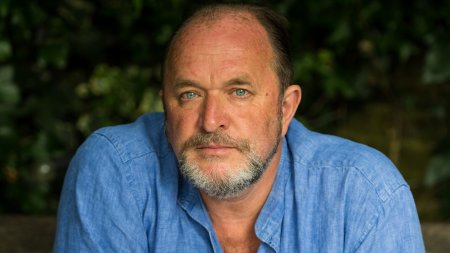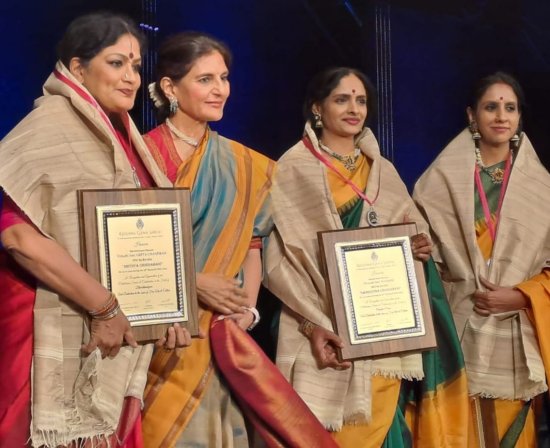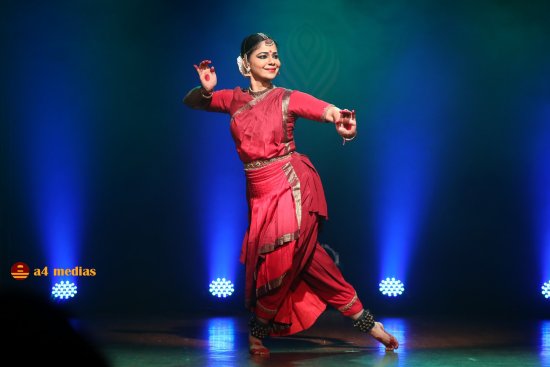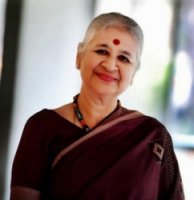
|   |

|   |
 e-mail: leelakaverivenkat@gmail.com Chennai swamped by Margazhi music/dance deluge January 4, 2025 Come Margazhi Season and with the deluge of music /dance and lectures on art in Chennai, one jumps grasshopper like from one Sabha to another, trying to absorb as much as one's energy and trafficking through bumpy and in places water-logged roads and alleys, will allow. In the desire not to miss out on opportunities, one often misses out on the luxury of sitting through entire events, ending up seeing parts of festivals playing out at various centres. LECTURE BY BRITISH HISTORIAN WILLIAM DALRYMPLE My start in this cornucopia of fare, very fittingly, happened to be a most absorbing lecture on how 'Ancient Indian art, religion, technology, astronomy, music, dance, literature, mathematics and mythology blazed a trail across the world', by the British historian William Dalrymple, who has made India his home. Having read his latest book The Golden Road on how India's contribution 'Transformed the World', I was particularly interested in this talk which had attracted a full auditorium at the Anna Library Centenary Hall. It was very heartening to hear about India having been the earliest trading partner of the Roman Empire, and a vital participant in the Silk Route (centuries before China), and to learn more about Chinese scholar Xuanzang who, in over sixteen years spent in travelling, lived for many years in Nalanda (which then housed 10,000 scholars!), returning to his homeland in 645 CE, to spread a sophisticated version of Mahayana Buddhism in China.  William Dalrymple The talk gave interesting details about the 'Fifth Concubine' Wu Zetian who rose to be an Empress after the death of the Chinese Emperor, even calling herself Chakravartin Zu (Sanskritic influence) and who officially made Buddhism the State religion - as the only woman ruler in Chinese history! It was enlightening to hear about the spread of Hinduism to many countries, with special reference made to Khmer! While it is not India but Borobudur which houses the biggest Buddhist temple, the largest Hindu temple is in Prambanan, as pointed out. In all probability considered India's greatest contribution according to the speaker, was in Mathematics - with the discovery of the zero by Aryabhatta, and further contributions by the likes of Brahmagupta and Varahamihira - this knowledge absorbed by the Middle East, through travelers spread to the west, and only through a rediscovery in the fifties, did all this become finally known to the world, as India's contribution. The speaker felt that India needed to make herself heard (like China for instance) to make the world aware of her contribution. In fairness to the speaker, it must be acknowledged that his was the only strong voice of criticism, about India finding no place in the recent Silk Route exhibition mounted in Britain curated by two British museums. NRITHYA CHOODAMANI AND SANGEETHA CHOODAMANI "Better late than never" is how I felt, watching Dr.Preetha Reddy, executive vice-chairman Apollo Hospitals, confer this year's Nrithya Choodamani award on Bharatanatyam dancer Geeta Chandran, during the inaugural function marking Krishna Gana Sabha's 68th Margazhi Mela. The music award of Sangeetha Choodamani went to the eminently deserving young awardees Ranjani and Gayatri.  Geeta Chandran, Dr.Preetha Reddy, Ranjani & Gayatri Geeta Chandran, while sharing with many other artistes of her ilk, combined expertise in Bharatanatyam dance and Carnatic music, for this critic, stands out in the panache with which she can conduct Bharatanatyam recitals - her Nattuvangam prowess wielding the cymbals - revealing a Nattuvanar like command much above what one sees among dance conductors today. This along with a love for literature with proven ability to speak on a range of subjects related to the arts, along with a willingness to spend quality time with each student, discussing and interacting on various art issues, make her a much sought after teacher, whose students never go in search of 'greener' pastures. Anita Ratnam in her felicitation talk referred to how, while trained in the old school of Swarna Saraswati, Geeta's artistic perspective is very comprehensive, incorporating with the same ease, the very traditional with the contemporary, along with a willingness to collaborate with artists from other disciplines like theatre, puppetry etc. Above all, the kind of loyalty she evokes in students, over the years, has created a band of hard working youngsters for her institution Natya Vriksha. The speaker also referred to the exemplary family support not only from parents but also from a husband who as the 'Dwarapala' guards her career, not excluding the support of the mother-in-law! Geeta, acknowledging the award, replied that with performance spaces not expanding enough to accommodate the ever growing dance fraternity, it was necessary for sabhas to be more inclusive and representative of changing audience perceptions. It was necessary to create more spaces for talking dance and discussing issues like the shrinking audiences seen today, for instance. Very warm in appreciation, Alleppey Venkatesan's felicitations for the singers Ranjani and Gayatri with their vast repertoire of compositions in Telugu, Tamil, Kannada, Marathi and Hindi, referred to their remarkable coordination, with appreciation for each other's prowess and their phenomenal voice control, along with a refined understanding of how to render Keertanams. Starting their career as violinists, when the twosome took the salutary step, (on advice), to shift to vocal music, there was no holding back their meteoric rise. Gayatri's reply mentioned that it was performing in Sabhas like this that they had grown wings! (now flying with titles and awards they attributed to legends). Art benefactor and President of Krishna Gana Sabha, Nalli Kuppuswami Chetty welcomed the gathering. Chief guest Preetha Reddy, referring to her Kalakshetra days, and the encouragement from her late father-in-law Obul Reddy, a renowned art benefactor and Carnatic music enthusiast, referred to the yearly Margazhi Season celebrations in Chennai, as a repository of the best in music and dance, ensuring the preservation of the cultural ethos of a people. The function was efficiently conducted by Saashwati Prabhu, the CEO of KGS, and granddaughter of Yagnaraman, the late founder of KGS and sabha culture in Chennai. Referring to the therapeutic power of Art, she said that Art endures even in this age dominated by screens and instant gratification, only because in its live form, it provides that bliss which enriches the inner individual and ensures transmission of a people's culture. She urged against the politicizing of Art. NAVIA'S VIRODHABHASA INTENSITY STRUGGLES AGAINST AUDIENCE RIGIDITY For a dancer trying out an intense work of choreography very much within the classical vocabulary but outside the Margam format, there is always the risk of running across an audience with rigid views on what the dance should be. And this happened to Navia Natarajan whose production Virodhabhasa investigating the profound nature of World Paradox, with its play of atoms, underlining the very premise on which life revolves round polar relationships of opposites, when presented at the Krishna Gana Sabha for the Margazhi Season, found an audience less receptive to fare outside the Margam. The subject concerned the Indian world view, which looks upon every aspect of life - animate, inanimate, geological or biological, not excluding our perceptions, as not existing in isolation or autonomy, but as part of a supreme reality, the macrocosm (ekam bija bahuda yah karati). There is no state-of-being without its opposite and as a matter of fact derives its identity from its opposite. Thus, we identify brightness by its opposite which is darkness. Everything like Purusha / Prakriti, Lingam / Yoni, light / darkness, life / death exists with two ends of its spectrum as opposites - each paradoxically, defined by its opposite other.  Navia Natarajan (Photo: a4medias) Expressing her gratitude to Sumantra Ghoshal for guiding and helping clarify her perspective, K.Geetanjali for providing insights and Preethi Athreya through exchanges, helping crystalize her thoughts, the dancer began after a brief introduction behind the closed curtain. The libretto comprised Sanskrit verses provided by Arjun Bharadwaj with the portions in Tamil, chosen by Prof S Raghuraman. Music for a theme of this nature plays a central role - and with music composition and orchestration by M.S. Sukhi and Deepu Nair and Janhavi Phansalkar providing vocal support with M.S. Sukhi on mridangam and with J.B. Sruti Sagar and Bhavani Prasad on flute and veena respectively, the dance effort had an experienced team as musical support. According to the dancer, It was a personal tragedy that triggered Navia's introspection into the very nature of life and existence - which appeared simultaneously as Maya and also real, posing before her the supreme paradox of form and formlessness (akaara and Niraakaara) represented in Shiva. The opening scene set in ragas like Revathi, Varamu and Sahana posed the riddle of Aakaara and Niraaakara - Form and Formlessness. 'Form is emptiness and emptiness is Form' maintains the Buddhist Sutra. Do opposites represent contradictions? 'Bho Shambho' mentions Chidanandaroopam referring to the bliss of that ultimate state of spiritual realization which is Shivoham. The next scene revolving round the paradox of Creation and Destruction was strung on ragas like Rasika Ranjani, Shubha Pantuvarali and Yaman. The cosmic activity of the cosmos moving with its play of atoms representing creation, preservation, destruction, Tirobhava (veiling embodiment, illusion and also giving rest), Anugraha (salvation or release), chit Ananda roopam becomes the central motif in the figure of the Dancing Shiva (Nataraja) "Our Lord is the celestial dancer who like the latent heat in firewood diffuses His power in mind and matter and makes them dance in their turn," says the Tiruvatuvar Puranam. The famous words in the Abhinaya Darpana "Angikam BhuvanamÖ" visualize the Lord in the entirety of the sky, whose speech represents all sounds in the universe and whose ornaments are the moon and the stars. With the Ganges on his head and fire in one hand, this dancing Shiva comprises all the five elements- Earth, Sky, Water, Air, and Fire. The Nataraja symbolism in details show drum held in one hand representing creation with the fire in the other representing destruction. While one hand in the Abhaya hasta stands for protection, the right leg stamping a dwarf symbolizes the crushing of the undivine or evil. What is born has to die - a truth which the world famous physicist woke up to, while watching sand castles brought in by one set of waves and washed away by another set - and suddenly it struck him that this was what was represented in the Nataraja motif. Set to ragas Rasika Ranjani, Subha Pantuvarali, Yaman, and calling on tremendous reserves of emotive involvement, Navia's really intense depiction in a seated posture, of the despair and revulsion of the aging process with ill health and disease and slow decay contrasting with the hope and joy of birth, was, one feels, overspun and needed to be edited. The next scene on the Paradox of Love, set to ragas Samantha Malahari and Dwijawanti was depicted through the Vachanas of 12th century Lingayat rebel saint Kavi of Kannada, Akka Mahadevi, representing women's emancipation, through highly unconventional, bold statements. (She believed that when God (Shiva) was all seeing and he was the soul mate she loved, there was no need to cover herself in clothes, and that husbands who died needed to be thrown to flames). In the emptiness following after the union with her Chennamallikarjuna (Shiva), she pines for the experience and ache of unfulfilled desire. Indeed this feeling underlines all of the world's love poetry, excelling in the absence thereof, than in its fulfillment. Finally comes the stillness of realization and this section is rightly based on the poetry of Kabir whose poetry urges to delve within oneself to find that alchemy and Anahata Baje which banishes all contrariness in the totally unified Ananda of self realisation, rightly set to Dhrupad music which goes beyond words and ragas Lavangi, Megh, Patdeep and Madhukauns, the end with the slokam of Poornamidam on what constitutes wholeness was perfect. Navia's Bharatanatyam, characterized by very expressive fingers, combines excellent lines with deep internalization and it was sad to see some of the audience walk out saying 'they had come to see dance!'. One feels that coming before the audience in front of the curtain and explaining in some detail what one is trying to convey through a non margam creation (which in no way flouts Bharatanatyam technique) which persons must view with an open mind, would perhaps prepare audiences, to look more favourably on such work, which calls for tremendous hard work on the part of the dancer and needs an audience whose thinking can accommodate new ideas.  Writing on the dance scene for the last forty years, Leela Venkataraman's incisive comments on performances of all dance forms, participation in dance discussions both in India and abroad, and as a regular contributor to Hindu Friday Review, journals like Sruti and Nartanam, makes her voice respected for its balanced critiquing. She is the author of several books like Indian Classical dance: Tradition in Transition, Classical Dance in India and Indian Classical dance: The Renaissance and Beyond. Responses * Navia Natarajanís 'Virodhabhasa' was originally commissioned by Mandala Arts and Culture, Vancouver, and premiered on VIMEO during the pandemic. - Mandala Arts and Culture (Jan 7, 2025) Post your comments Please provide your name and email id along with your comment. All appropriate comments posted with name and email id in the blog will also be featured in the site. |